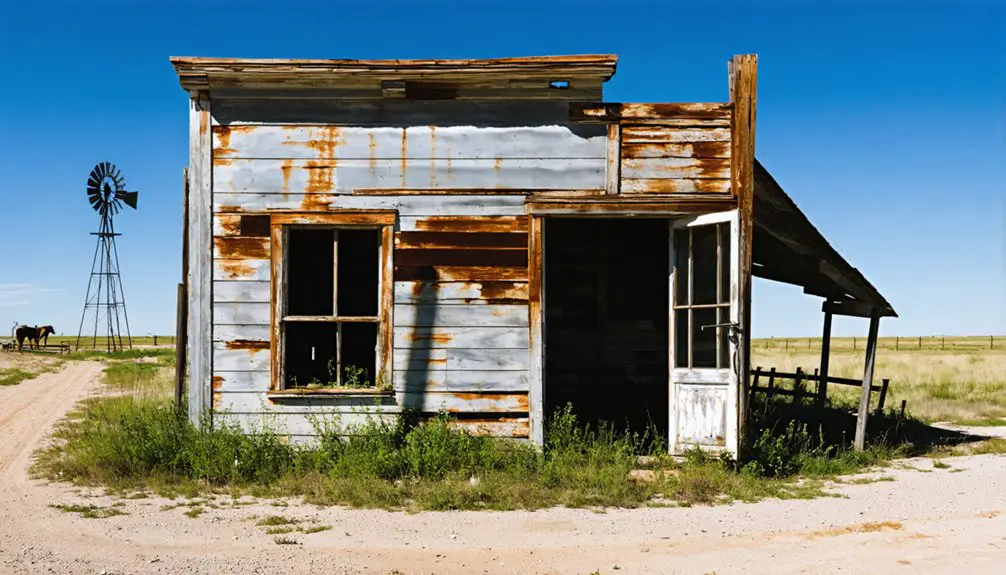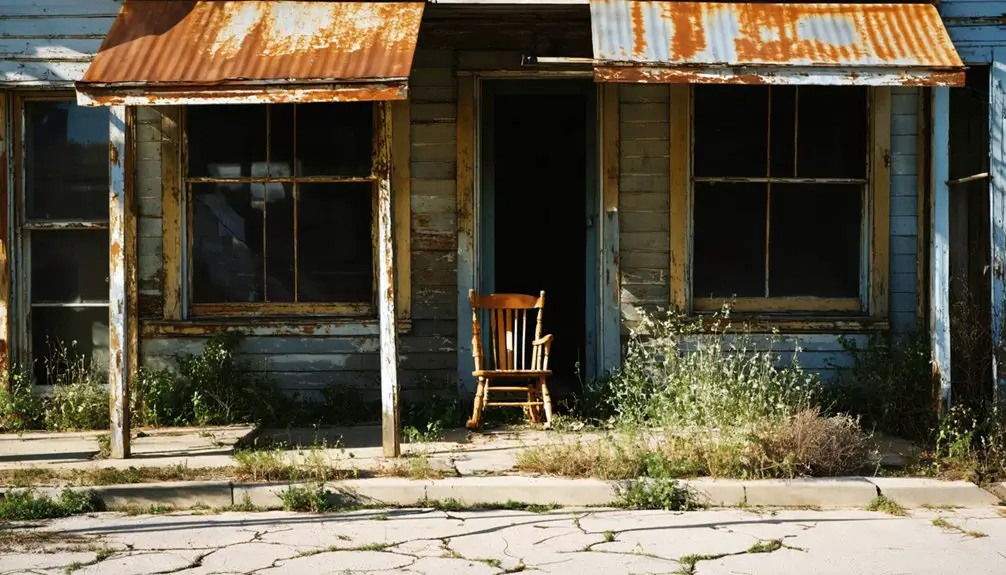You’ll find Fort Belknap‘s remains in Young County, Texas, where this frontier outpost transformed from a military fort into a thriving community center in 1851. The settlement played a vital role in defending Texas’s northern frontier against Comanche raids while serving as a hub along the Butterfield Overland Mail route. Though now a ghost town, its preserved 15-acre site, including original stone buildings and artifacts, reveals fascinating layers of Texas’s frontier heritage.
Key Takeaways
- Fort Belknap’s surrounding settlement became a ghost town after military abandonment and relocation of the county seat to Graham.
- Originally serving as Young County’s administrative center, Belknap declined when the fort closed in 1867.
- The community once thrived with civilian homes and businesses centered around military operations and the Butterfield Stage route.
- Historical structures remain preserved at the 15-acre site, including original stone buildings from the fort’s active period.
- Modern visitors can explore restored buildings and artifacts at Fort Belknap, though the original town no longer exists.
Origins of Fort Belknap Settlement
While many frontier outposts began as simple military camps, Fort Belknap emerged as a strategically planned settlement in 1851 under the direction of Brevet Brigadier General William G. Belknap.
You’ll find the fort’s original location was moved due to water scarcity, settling near life-giving springs by the Brazos River.
Unlike typical frontier forts, you won’t see defensive walls or earthworks at Belknap. Instead, the fort establishment focused on creating a community hub that quickly grew into Texas’s largest compound.
Within just two years, you’d have found a thriving military presence complete with an infantry band and library. The settlement dynamics transformed the area into Young County’s administrative center, with civilian homes and businesses sprouting up around the military installation. The fort’s initial structures were built using adobe construction materials, later being replaced with more durable stone buildings. Under the command of the Fifth Infantry, the fort worked to maintain peace between settlers and local tribes.
Military Significance and Frontier Defense
Fort Belknap’s strategic position on the Brazos River near Newcastle made it an essential military outpost for defending Texas’s northern frontier against Kiowa and Comanche raids.
You’ll find that the fort served as the northernmost anchor in a chain of defensive posts stretching from the Rio Grande to the Red River, securing critical transportation routes including the Fort Smith-El Paso Road and Butterfield Overland Mail.
The fort’s troops, including companies from the 5th and 7th U.S. Infantry regiments, conducted regular patrols and launched offensive expeditions into Indian territories, though they operated without traditional fortifications like walls or trenches. The site was initially established in June of 1851 when military leaders recognized the need for protection against Indian attacks. The military presence grew to include four companies at its peak, demonstrating the fort’s significance in frontier defense.
Strategic Frontier Post Location
Situated at a critical northern position along the Texas frontier line, Belknap served as an essential military outpost connecting a chain of forts from the Rio Grande to the Red River.
The fort’s location near the Brazos River provided significant water resources while enabling control over major emigration and mail routes, particularly the Fort Smith-El Paso Road. The fort became a vital hub for the Butterfield Overland Mail and developed an extensive network of roads. You’ll find that this strategic fort location was carefully chosen to protect settlers and maintain important communication networks across the expanding western frontier.
As the northernmost anchor in Texas’s frontier defense system, Belknap linked southern fortifications like Forts Worth, Gates, and Lincoln. The site’s U.S. Army troops actively pursued Native American raiding parties to protect the region’s settlers.
Its position allowed troops to effectively patrol the region, deterring Kiowa and Comanche raids while supporting friendly tribes like the Tonkawa.
Cavalry and Indian Raids
Throughout the late 1850s, Fort Belknap served as a critical staging ground for major cavalry operations against Comanche raiders, most notably Captain Earl Van Dorn’s 1858-59 Wichita Expedition.
You’ll find that Van Dorn’s cavalry tactics proved highly effective, utilizing 250 troops and 135 Indian allies to strike deep into Indian Territory from Camp Radziminski.
While military expeditions achieved victories at Rush Springs and Crooked Creek, the fort’s presence couldn’t prevent all raids. Like the later campaigns of Colonel Ranald Mackenzie, who led the 4th U.S. Cavalry in bold strikes against raiders.
You’d have witnessed large-scale Kiowa and Comanche attacks within miles of the fort, including the devastating 1864 Elm Creek raid. The raid involved six-hundred Kiowa and Comanche warriors who devastated the local settlement.
Indian alliances remained complex, as Fort Belknap’s troops protected reservation Indians from settler violence while simultaneously pursuing hostile bands.
This tension culminated in the 1859 assassination of Indian Agent Robert S. Neighbors in Belknap town.
Life in Early Belknap Community
During the 1850s and 1860s, life in the Belknap community revolved around a diverse mix of soldiers, settlers, and Native Americans who shaped the town’s unique character.
The community dynamics centered around Fort Belknap, which served as both a military outpost and a crucial hub for trade, supplies, and mail delivery along the Butterfield Overland Stage route.
Fort Belknap stood as a vital frontier crossroads, where military presence merged with commerce along the Butterfield Stage route.
Daily challenges included securing water from the Brazos River springs and defending against raids, with settlers often “forting up” their homes for protection. Locals relied on abundant wildlife like deer and bison for sustenance. Similar to the Elm Creek Raid that devastated neighboring Proffitt, the town faced persistent threats from Kiowa and Comanche attacks.
Yet, you’d find signs of civilization taking root – a Methodist Episcopal church, a school, and a Masonic Lodge.
Despite the frontier’s rough nature, with its saloons and gambling halls, the town maintained cultural activities through its military bands and library, while the local economy thrived on military spending, ranching, and agriculture.
The Town’s Rise and Decline
Belknap’s story of growth and eventual decline began in 1851 when settlers established the town near the newly constructed Fort Belknap, named after General William Goldsmith Belknap.
You’ll find settlement patterns were initially shaped by the fort’s protective presence, as pioneers sought safety from Comanche and Kiowa raids along the frontier line.
The town’s strategic location near transcontinental routes and its status as Young County’s first county seat spurred early prosperity.
However, economic shifts hit hard when federal troops abandoned the fort in 1861.
Despite brief reoccupation during the Civil War, Belknap’s importance faded. The loss of both military protection and county seat status triggered an exodus of settlers, and by the late 1860s, your once-thriving frontier town had transformed into a ghost town, with few structures remaining today.
Historical Sites and Preservation Efforts

When you visit Fort Belknap today, you’ll find carefully restored stone buildings including the commissary, kitchen, barracks, and well, most reconstructed on their original foundations during the 1936 Texas Centennial project.
The Fort Belknap Society manages two museums housed in the historic commissary and corn house, where you can explore military artifacts, period clothing, and everyday items from frontier life.
Through educational programs and guided tours, you’ll learn about the fort’s vital role in Texas frontier defense while experiencing hands-on history preserved by dedicated volunteers and staff.
Historic Building Restoration
The remarkable restoration journey of Fort Belknap stands as a tribute to Texas’s commitment to preserving its frontier heritage.
You’ll find meticulous restoration techniques employed across the 15-acre site, where stone masonry and wooden structures have been carefully preserved to maintain their authentic 19th-century character.
Key preservation challenges include:
- Managing natural deterioration in Texas’s semi-arid climate
- Balancing public access with site integrity through controlled hours
- Maintaining historical accuracy using archival documents and diaries
The restored two-story commissary now serves as a museum, while the granary hosts the Women’s Building featuring historical gowns.
You’ll discover the grape arbor, planted after military abandonment, provides an authentic backdrop for community events, connecting you directly to the fort’s rich past.
Community Educational Programs
Dedicated to preserving frontier heritage, Fort Belknap’s educational programs offer visitors immersive experiences through museum exhibits, guided tours, and interpretive displays.
You’ll discover artifacts like tools, clothing, and arrowheads that tell the story of Texas frontier life in the museum’s carefully curated collections.
The fort’s educational outreach extends through partnerships with Texas Wesleyan College, supporting research and public programming at the Fort Belknap Archives of Western America.
Regular interpretive programs include historical reenactments, local history lectures, and youth-focused field trips that bring frontier history to life.
Through the repurposed infantry barracks, now serving as a community center, you’ll find workshops and cultural events that strengthen public appreciation for this significant heritage site.
Community volunteers help preserve these educational initiatives while fostering local stewardship of Fort Belknap’s rich history.
Legacy in Texas Frontier History
Established in 1851 as a strategic military outpost, Fort Belknap‘s enduring legacy spans far beyond its operational years, shaping the development of Texas’s northern frontier and leaving an indelible mark on the state’s territorial expansion.
Today, you’ll find this cultural heritage preserved as a National Historic Landmark, telling the story of America’s westward progression.
The fort’s historical narratives reveal three significant impacts on Texas frontier development:
- Created a foundation for settler communities, leading to the establishment of essential trade routes and communication networks
- Served as a symbol of American military resistance against raids, though settlers often maintained their independence through self-defense
- Transformed the regional landscape by establishing a protective boundary that enabled the advancement of settlements from the Rio Grande to the Red River
Frequently Asked Questions
What Crops Were Primarily Grown by Early Settlers Around Belknap?
You’d find wheat as your primary crop, alongside corn cultivation for local consumption. Cotton farming emerged later, while oats and rye supplemented your farming efforts around the military post.
Did Any Famous Outlaws or Gunfighters Ever Visit Fort Belknap?
You won’t find any documented outlaw encounters or gunfighter legends at Fort Belknap – it primarily served as a military outpost focused on protecting settlers and managing relations with Native American tribes.
How Did Residents Get Medical Care in Early Belknap?
Like pioneers facing the Oregon Trail, you’d have relied on local healers, Fort Belknap’s military doctors, or traveled to McLennan County’s eleven physicians for limited healthcare access and basic medical practices.
What Were Typical Wages for Civilian Workers at Fort Belknap?
You’d have found civilian employment at Fort Belknap paying $1-2 daily for basic labor, while skilled workers like blacksmiths earned up to $2.50. Wage comparisons show rates aligned with other Texas forts.
Were There Any Documented Supernatural Occurrences at Fort Belknap?
While you’ll find stories of ghostly sightings around the fort’s hospital and morgue, there aren’t any scientifically documented paranormal investigations or officially confirmed supernatural events at Fort Belknap.
References
- https://www.legendsofamerica.com/tx-fortbelknap/
- https://en.wikipedia.org/wiki/Fort_Belknap_(Texas)
- https://www.texasalmanac.com/articles/fort-belknap-the-pre-civil-war-frontier
- https://visitgrahamtexas.com/things-to-do/fort-belknap/
- https://mansfieldphoto.com/small-towns-of-texas/newcastle-texas-belknap/
- https://www.tshaonline.org/handbook/entries/belknap-tx
- https://www.texasescapes.com/TexasTowns/Fort-Belknap-Texas.htm
- https://www.tshaonline.org/handbook/entries/fort-belknap
- https://texoso66.com/2017/10/26/fort-belknap/
- https://wildcatterranch.com/history



